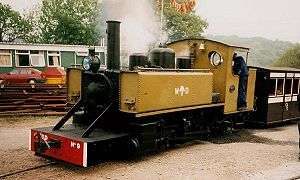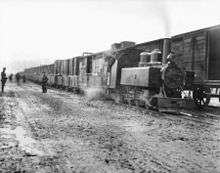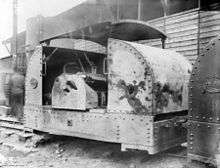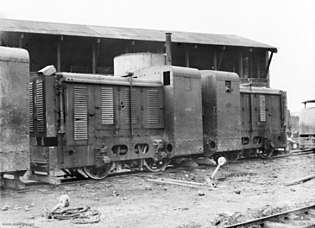War Department Light Railways
The War Department Light Railways were a system of narrow gauge trench railways run by the British War Department in World War I. Light railways made an important contribution to the Allied war effort in the First World War, and were used for the supply of ammunition and stores, the transport of troops and the evacuation of the wounded.
Track gauges
Different track gauges were used in different parts of the world including 600mm, 760 mm (2 ft 5 15⁄16 in), 1,000 mm (3 ft 3 3⁄8 in) metre gauge and 1,050 mm (3 ft 5 11⁄32 in).
The military light railways in France were of 600 mm (1 ft 11 5⁄8 in) gauge and used a variety of steam and petrol locomotives from French, British and American builders. The Germans installed their 600 mm (1 ft 11 5⁄8 in) gauge Feldbahn system early in the war. Trench railways of the World War I western front produced the greatest concentration of minimum-gauge railway locomotives observed to date.[1]
Development

Britain came to the belated realisation that it needed a flexible and reliable method of supplying the front lines, bringing shells, timber, and fodder from the rear areas and their standard gauge supply points. Narrow gauge light railways were the solution.
Hundreds of locomotives were built by companies such as Hunslet, Kerr Stuart, ALCO, Davenport, Motor Rail and Baldwin to work these lines. Also, Model T Ford conversions were used. Thirty or so Companies were formed within the Royal Engineers to staff the lines. These were mostly British ex-railwaymen pressed into service, though Australian, South African and Canadian gangs served with distinction. An American unit also served under the British flag.
Each area of the front would have its own light rail to bring up materiel. The British perfected roll on roll off train ferries[2] to bring fodder and supplies direct from England via train ferries to France. Northern French rail lines were under direct military control of the Army in the area.
By 1917, the Canadians led the way in showing the utility of light railways. Having built thousands of miles of new frontier track in Western Canada in the previous decades, these "colonials", led by J. Stewart, supplied the Canadian Corps who went on to victory at Vimy. From this the light railways were expanded to 700 miles (1,100 km) of track, which supplied 7,000 tons of supplies daily. The ebb and flow of war meant that rail lines were built and rebuilt, moved and used elsewhere, but by the latter years of Passchendaele, Amiens and Argonne, light railways came into their own and pulled for the final victory.
WDLR locomotives
A large number of locomotives[3] (mostly of 600 mm (1 ft 11 5⁄8 in) gauge) was ordered for the WDLR. These included:
Steam


- Hudson 0-6-0WT (built by Hudswell Clarke)
- Barclay 0-6-0WT
- Hunslet 4-6-0T
- Baldwin Class 10-12-D 4-6-0T
- ALCO 2-6-2T
- Dimensions[4]
| Dimension | Hudson | Barclay | Hunslet | Baldwin | Alco |
|---|---|---|---|---|---|
| Wheel arrangement | 0-6-0WT | 0-6-0WT | 4-6-0T | 4-6-0T | 2-6-2T |
| Driving wheels | 1 ft 11 in (584 mm) | 1 ft 10 in (559 mm) | 2 ft 0 in (610 mm) | 1 ft 11.5 in (597 mm) | 2 ft 3 in (686 mm) |
| Tank capacity Imperial gallons L US gallons |
110 imp gal (500 L; 130 US gal) | 110 imp gal (500 L; 130 US gal) | 375 imp gal (1,700 L; 450 US gal) | (476 US gal or 1,800 L or 396 imp gal) | 396 imp gal (1,800 L; 476 US gal) |
| Fuel capacity | 3.5 long hundredweight (180 kg; 390 lb) | 3.5 long hundredweight (180 kg; 390 lb) | 15 long hundredweight (760 kg; 1,700 lb) | 15 long hundredweight (760 kg; 1,700 lb) | 15 long hundredweight (760 kg; 1,700 lb) |
| Cylinders | 6.5 in × 12 in (165 mm × 305 mm) | 6.75 in × 10.75 in (171 mm × 273 mm) | 9.5 in × 12 in (241 mm × 305 mm) | 9 in × 12 in (229 mm × 305 mm) | 9 in × 14 in (229 mm × 356 mm) |
| Working pressure | 180 psi (1,200 kPa) | 160 psi (1,100 kPa) | 160 psi (1,100 kPa) | 178 psi (1,230 kPa) | 175 psi (1,210 kPa) |
| Tractive effort at 75% working pressure |
2,970 lbf (13.2 kN) | 2,672 lbf | 5,415 lbf (24.09 kN) | 5,398 lbf (24.01 kN) | 5,512 lbf |
| Weight in working order |
6.98 long tons (7.82 short tons; 7.09 t) | 6.38 long tons (7.15 short tons; 6.48 t) | 14.05 long tons (15.74 short tons; 14.28 t) | 14.50 long tons (16.24 short tons; 14.73 t) | 17.09 long tons (19.14 short tons; 17.36 t) |
Internal combustion


- Motor Rail (Simplex) 20 hp (15 kW), petrol
- Motor Rail (Simplex) 40 hp (30 kW), petrol
- British Westinghouse 45 hp (34 kW), petrol-electric
- Dick, Kerr & Co. 45 hp (34 kW), petrol-electric
- Baguley (McEwan Pratt) 10 hp (7.5 kW), petrol-paraffin engine
- Dimensions[5]
| Dimension | Simplex 20 hp | Simplex 40 hp | Petrol-electric | McEwan Pratt |
|---|---|---|---|---|
| Overall length | 8 ft 3 in (2,515 mm) | 11 ft 2 in (3,404 mm) | 15 ft 1 in (4,597 mm) | 9 ft 0 in (2,743 mm) |
| Wheel diameter | 1 ft 6 in (457 mm) | 1 ft 6 in (457 mm) | 2 ft 8 in (813 mm) | n/k |
| Weight loaded (long tons-cwt) short tons tonnes |
1 long ton 18 cwt (2.1 short tons; 1.9 t) | 6 long tons 3 cwt (6.9 short tons; 6.2 t) | 8 long tons 0 cwt (9.0 short tons; 8.1 t) | 1 long ton 18 cwt (2.1 short tons; 1.9 t) |
| Cylinders | 2 | 4 | 4 | 2 |
| Horsepower | 20 hp (15 kW) | 40 hp (30 kW) | 55 hp (41 kW) (engine) 45 hp (34 kW) (motors) |
10 hp (7.5 kW) |
Captured
A few captured German feldbahn locomotives were also used but these usually had short lives because no spare parts were available for them.
Other locomotives
Both the French Army and the U.S. Army had their own locomotives, which included:
French Army
- Decauville 0-6-0T
- Pechot Bourdon 0-4-4-0T
Preserved locomotives
Baldwin

Probably the most famous of these war service engines were of class 10-12-D, built by the Baldwin Locomotive Works, U.S. Nearly 500 were built and those that survived the war found new homes around the world. Many went to India and after the war a few went to railways in Britain including:
Hunslet
Hunslet 4-6-0 Locomotive no. 1229 of 1916, formerly of Cattle Creek Mill, is currently stored at ANGRMS, Woodford QLD, Australia. Awaiting restoration.[6]
Hunslet 4-6-0 Locomotive no. 1218 of 1916, formerly of Gin Gin Mill, is currently with D.Revell, Weewaa, New South Wales, Australia.[7] It may well be the Hunslet WW I trench tram now preserved at the Canberra War Museum, Australia.
Hunslet 4-6-0 Locomotive no. 1239 of 1916, retrieved from a public park in Mackay, restored at the Rail Workshops Museum, currently on display at the Rail Workshops Museum, North Ipswich, Queensland, Australia [8]
See also
References
- Small 1982, p. 56.
- Duckworth, Christian Leslie Dyce; Langmuir, Graham Easton (1968). Railway and other Steamers. Prescot, Lancashire: T. Stephenson and Sons.
- "War Department Light Railways". Wdlr.org.uk. Retrieved 4 August 2014.
- Davies 1967, p. 152.
- Davies 1967, p. 162.
- "ANGRMS Collection: Hunslet" (PDF). Australian Narrow Gauge Railway Museum Society. 5 June 2010.
- "(untitled photo)". War Department Light Railways.
- Hinchliffe, Jessica (10 November 2017). "Train from WWI restored by volunteers at Ipswich". ABC News. Retrieved 11 November 2017.
Sources
- Baker, Stuart (1983). "Gas Mechanicals". Narrow Gauge and Short Line Gazette. Cite journal requires
|journal=(help) - Davies, W.J.K. (1967). Light Railways of the First World War. Newton Abbot: David & Charles.
- DeNevi, Don & Hall, Bob (1992). United States Military Railway Service America's Soldier Railroaders in WWII. Erin, Ontario: Boston Mills Press. ISBN 1-55046-021-8.
- Dunn, Rich (1979). "Military Light Railway Locomotives of the U.S.Army". Narrow Gauge and Short Line Gazette.
- Dunn, Rich (1982). "Military Light Railway Rolling Stock of the U.S.Army". Narrow Gauge and Short Line Gazette.
- Seidensticker, Walter (1980). "Brigadeloks and Zwillinge in the Trenches". Narrow Gauge and Short Line Gazette.
- Small, Charles S. (1982). Two-Foot Rails to the Front. Railroad Monographs.
- Telford, Robert (1998). "Belligerent Baldwins". British Railway Modelling.
- Westwood, John (1980). Railways at War. San Diego, California: Howell-North Books. ISBN 0-8310-7138-9.